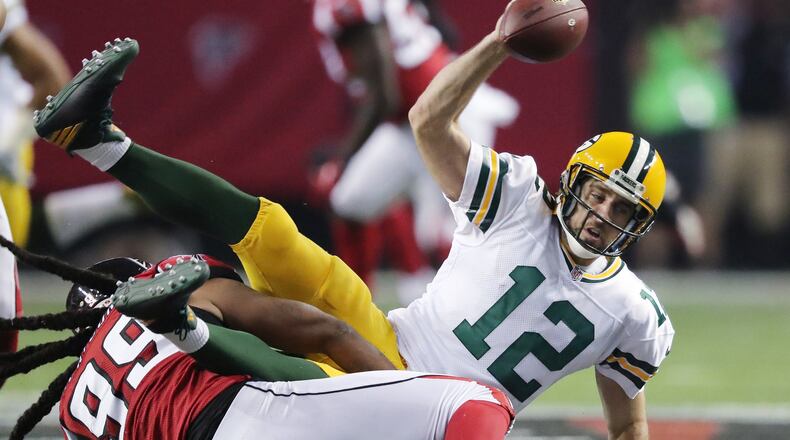Falcons coach Dan Quinn considers it a win when his pass rushers can move the opposing quarterback “off his spot” even if they don’t get the sack. But the problem with making Packers quarterback Aaron Rodgers move is that he still can make plays on the run.
The Falcons didn’t slow down the Packers on Sunday until they made Rodgers stay in the pocket and got him on the ground. Two key second-half sacks by defensive end Adrian Clayborn helped the Falcons pull out a 33-32 victory at the Georgia Dome.
“I don’t think it was magic,” Clayborn said. “I think we were just rushing hard and we finally were able to get to him.”
The Packers were so thin at running back because of injuries they essentially abandoned the run. That allowed the Falcons to aggressively rush Rodgers but the visitors still were effective offensively, especially in the first half, because Rodgers consistently escaped pressure to complete passes.
“It’s hard to contain a guy who has no rules on where he can go,” Falcons defensive end Dwight Freeney said. “He’s going to go wherever. It does not matter.”
Vic Beasley got the first sack against Rodgers when Courtney Upshaw flushed him from the pocket. That forced Green Bay’s first punt of the game.
Clayborn got to Rodgers twice on third downs in the third quarter.
Clayborn dropped Rodgers for an eight-yard loss early in the period and the Falcons took the ensuing punt to score a go-ahead touchdown. Clayborn sacked Rodgers again on the final play of the third quarter, forcing another Packers punt.
At times in the second half Beasley served as a “spy” against Rodgers, eschewing the pass rush and instead stayiung back to limit Rodgers’ running options.
“I think collectively, from the secondary on down, we were a little bit more aware of how they were trying to attack us from a route perspective,” Freeney said. “Defensively from a front standpoint we synced it in and we had a couple big third-down stops that helped change the momentum.”
Before then, Rodgers had confounded the Falcons with his mobility while delivering all four of his TD passes from outside of the pocket.
In the first quarter, Rodgers stepped to his right when Vic Beasley pressured him from the inside and threw a sizzling pass across his body to Jordy Nelson for a five-yard score. In the second quarter Clayborn and Upshaw rushed from the outside and Rodgers ran to his right before throwing a four-yard TD pass to Geronimo Allison.
After the Falcons pulled within 14-13, Rodgers again delivered a TD pass on the run, this time sprinting to his right and muscling a pass to Trevor Davis in the front corner of the end zone with Falcons quarterback Brian Poole in tight coverage. On his TD pass that put the Packers ahead with 3:58 to play, Rodgers shuffled to his left and threw a seven-yard TD pass to Jeff Janis.
Three other times Rodgers got outside and ran for key gains.
Rodgers sprinted for 23-yard gain that led to a Packers field goal late in the first half. On Green Bay’s go-head TD drive in the fourth quarter Rodgers ran up the middle for 11 yards on a second-and-nine and ran around right end for 13 yards to the Falcons’ 24-yard line on third-and-three. Rodgers also ran for a two-point conversion after his TD pass to Janis.
The Falcons eventually slowed Rogers just enough to win.
“As you can see, it’s difficult,” Clayborn said. “The game plan we had, it was rough because you expect him to go one way and then you get in the game and he goes a different way. We had a good game plan. It’s just when you are playing a quarterback like that sometimes it doesn’t go the way you want it to go. But we adjusted and we got after it.”
About the Author
Keep Reading
The Latest
Featured


